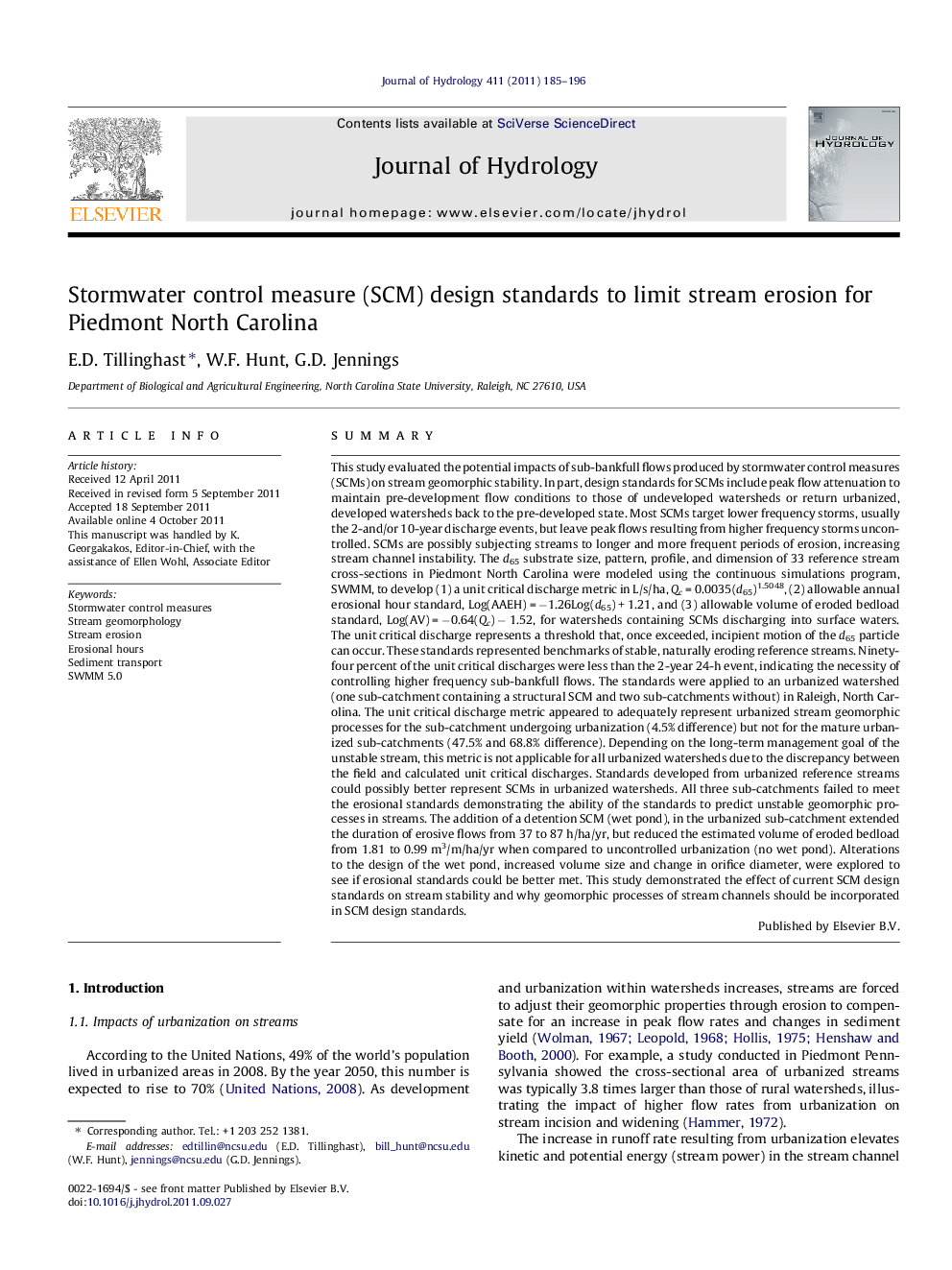| کد مقاله | کد نشریه | سال انتشار | مقاله انگلیسی | نسخه تمام متن |
|---|---|---|---|---|
| 4577325 | 1630006 | 2011 | 12 صفحه PDF | دانلود رایگان |

SummaryThis study evaluated the potential impacts of sub-bankfull flows produced by stormwater control measures (SCMs) on stream geomorphic stability. In part, design standards for SCMs include peak flow attenuation to maintain pre-development flow conditions to those of undeveloped watersheds or return urbanized, developed watersheds back to the pre-developed state. Most SCMs target lower frequency storms, usually the 2-and/or 10-year discharge events, but leave peak flows resulting from higher frequency storms uncontrolled. SCMs are possibly subjecting streams to longer and more frequent periods of erosion, increasing stream channel instability. The d65 substrate size, pattern, profile, and dimension of 33 reference stream cross-sections in Piedmont North Carolina were modeled using the continuous simulations program, SWMM, to develop (1) a unit critical discharge metric in L/s/ha, Qc = 0.0035(d65)1.5048, (2) allowable annual erosional hour standard, Log(AAEH) = −1.26Log(d65) + 1.21, and (3) allowable volume of eroded bedload standard, Log(AV) = −0.64(Qc) − 1.52, for watersheds containing SCMs discharging into surface waters. The unit critical discharge represents a threshold that, once exceeded, incipient motion of the d65 particle can occur. These standards represented benchmarks of stable, naturally eroding reference streams. Ninety-four percent of the unit critical discharges were less than the 2-year 24-h event, indicating the necessity of controlling higher frequency sub-bankfull flows. The standards were applied to an urbanized watershed (one sub-catchment containing a structural SCM and two sub-catchments without) in Raleigh, North Carolina. The unit critical discharge metric appeared to adequately represent urbanized stream geomorphic processes for the sub-catchment undergoing urbanization (4.5% difference) but not for the mature urbanized sub-catchments (47.5% and 68.8% difference). Depending on the long-term management goal of the unstable stream, this metric is not applicable for all urbanized watersheds due to the discrepancy between the field and calculated unit critical discharges. Standards developed from urbanized reference streams could possibly better represent SCMs in urbanized watersheds. All three sub-catchments failed to meet the erosional standards demonstrating the ability of the standards to predict unstable geomorphic processes in streams. The addition of a detention SCM (wet pond), in the urbanized sub-catchment extended the duration of erosive flows from 37 to 87 h/ha/yr, but reduced the estimated volume of eroded bedload from 1.81 to 0.99 m3/m/ha/yr when compared to uncontrolled urbanization (no wet pond). Alterations to the design of the wet pond, increased volume size and change in orifice diameter, were explored to see if erosional standards could be better met. This study demonstrated the effect of current SCM design standards on stream stability and why geomorphic processes of stream channels should be incorporated in SCM design standards.
► Erosion metrics for stormwater control measures (SCMs) that target stream geomorphology.
► Stormwater critical discharge standards can be established from the d65 of streams in Piedmont region of North Carolina.
► Annual erosional hours and sediment transported in urbanized watersheds can predict uncontrolled erosion within streams.
► Catchment design and SCM sizing can reduce negative impact of development on stream geomorphologic health.
► Better critical discharge standards may be possible by analyzing stable and healthy urban stream segments.
Journal: Journal of Hydrology - Volume 411, Issues 3–4, 9 December 2011, Pages 185–196